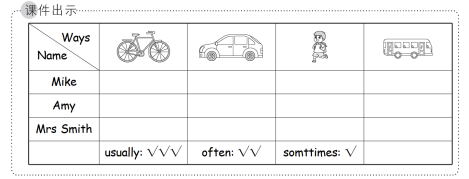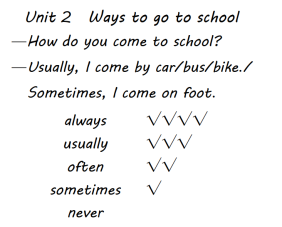人教pep六上英语 Unit 2 The first period 第一课时 教案
Unit 2 Ways to go to school
![]()
教材分析 | 本单元学习的主题是交通方式和交通规则。教学内容主要是通过展示教材主要人物上学路上交通出行的情景来展开的。教学重点是能够听、说、读、写核心句型“—How do you come to school? —I usually/sometimes/often come/go…”“Don’t…”“I/You must…”;能够听、说、读、写单词和词组:by plane, by train, by taxi, by ship, on foot, by bus, by subway, wait, slow down, go, stop |
教学目标 | 知识与能力目标: ·能够听、说、读、写句型“—How do you come to school? —I usually/sometimes/often come on foot.”“Don’t go at the red light.”“I must pay attention to the traffic lights.” ·能够在情景中运用句型“—How do you come/go…? —I usually/sometimes/often come/go…” 谈论交通方式 ·能够在情境中运用句型“Don’t…”“I/You must…”谈论交通规则 ·能够在图片的帮助下正确理解并按照正确的意群及语音、语调朗读杂志里有关上学交通 方式的报道,运用本单元所学核心句型给同伴提出安全出行的建议,同时能仿照范例绘 制自己的交通规则海报 ·能够听、说、读、写单词和词组:by plane, by train, by taxi, by ship, on foot, by bus, by subway, wait, slow down, go, stop ·能够正确使用上述单词和词组谈论或描述交通方式和交通规则 ·知道英语句子中单词之间的连读现象 情感态度、文化意识、学习策略目标: ·了解不同国家学生上学的交通方式 ·能够辨认一些常见的交通标志,了解并遵守交通规则 ·知道英国和中国驾驶习惯的差异 ·能够通过看图捕捉主要信息,并根据提示做出听前预测 ·能够通读文段,获取主旨大意和细节信息,并能进行推理判断 |
课时安排 | 第一课时: Part A Let’s try & Let’s talk 第二课时: Part A Let’s learn & Write and say 第三课时: Part B Let’s try & Let’s talk 第四课时: Part B Let’s learn & Role-play 第五课时: Part B Read and write 第六课时: Part B Let’s check & Let’s wrap it up & Part C Story time |
The first period(第一课时)
Part A Let’s try & Let’s talk ![]()
▶教学内容与目标
课时教学内容 | 课时教学目标 |
Let’s try | ·能够读懂题目要求,并通过观察Let’s try板块的图片,对听力部分的重点内容进行预测 ·通过听录音,能够运用基本的听力技巧完成Let’s try板块的听力任务 |
Let’s talk | ·通过观察、谈论Let’s talk板块的图片,在图片、PPT和老师的帮助下理解对话大意,并 ·能够回答对话下面的问题 ·通过听录音,学会按照正确的意群及语音、语调朗读对话,并能够在小组中进行角色表演 ·能够听、说、读、写并在情景中恰当运用句型“—How do you come to school? —I usually/sometimes/often come…”提问及作答 |
▶教学重点
1. 能够理解和掌握本课时重点词汇及句型。
2. 能够在情景中运用句型“—How do you come to school? —I usually/sometimes/often come…”提问及作答。
▶教学难点
能够在情景中恰当运用句型“—How do you come to school? —I usually/sometimes/often come…”提问及作答。
▶教学准备
PPT课件、课文录音、视频、卡片等。
 ▶教学过程
▶教学过程
1
Step 1: Warm-up & Lead-in
1. Greetings.
2. Let’s watch and sing.
Play the video of the song in Unit 2—How do you get there?(出示课件)
T:What can you see in the video?
Ss:Subway, taxi, airplane, ship…
T:Yes, you are right. There are many ways to go to some places.
3. Look and predict.
 Show the pictures of the main scene of Unit 2 in the textbook. (课件出示:Unit 2主情景图) Let students look at the pictures carefully. Then ask some questions to lead them to predict the main idea of the dialogues.
Show the pictures of the main scene of Unit 2 in the textbook. (课件出示:Unit 2主情景图) Let students look at the pictures carefully. Then ask some questions to lead them to predict the main idea of the dialogues.
The questions are like these:
①Where are they? (They are at a crossroads/at school.)②What can you see? (Four people and a subway station./Amy, Mike and many bikes.)
③What are they talking about? (Ways to go to school.)
T:Yes! In this unit we’re going to talk about “Ways to go to school”.
Write down the topic “Unit 2 Ways to go to school” on the blackboard.
 Step 2: Presentation
Step 2: Presentation
1. Listen and tick or cross.
(1)Students read the sentences of “Let’s try” by themselves and get the information:
Who?(Amy and Mike.)/Where?(At school.)/When? (This morning.)
(2)Show the sentences on the PPT. Let students predict and guess the answers. (课件出示:教材P14 Let’s try板块的内容)
(3)The teacher plays the recording of “Let’s try”. (出示课件) Students try to tick or cross the sentences.
(4)The teacher plays the recording again. Students read the dialogue and check the answers. (课件出示:教材P14 Let’s try 板块的音频、听力材料及答案)
 2. Look, guess and chant.
2. Look, guess and chant.
Show the pictures of the part of the bike, the car and the bus. (课件出示:自行车、小汽车和公共汽车的一些局部图片) Let students guess.
Teach the words and the phrases “bike, car, bus , by bike/car/bus” with the pictures.(出示课件)
T: I come to school by car.
Lead students to make sentences: I come to school by bike /car /bus.
Then students read a chant together. (课件出示:与交通方式有关的歌谣)
3. Learn the new dialogue.
(1)Use the teacher’s language to penetrate the sentences. Then teach the sentence “How do you come to school?”
T:Today, I come to school at 7:00. I’m early. I come to school by bike. How do you come to school?
S1:I come to school by car.
T:How about you?
S2:I come to school by bike.
T:That’s good exercise. Well, do you know how Mike, Amy and Mrs Smith come to school? Now, let’s have a look.
(2)Show the picture of “Let’s talk”. (课件出示:教材P14 Let’s talk板块的图片) Let students predict the main idea of the dialogue.
 (3)Let students watch the video of “Let’s talk” and try to find the traffic tools in the chart. (课件出示:教材P14 Let’s talk板块的视频及相应的表格)
(3)Let students watch the video of “Let’s talk” and try to find the traffic tools in the chart. (课件出示:教材P14 Let’s talk板块的视频及相应的表格)

Write down the phrase “on foot” on the blackboard and teach it.
(4)Let students watch the cartoon again with the following questions.


Let students know “I usually walk.=I usually come on foot.”
Write down the words “always, usually, often, sometimes, never” on the blackboard. And use the numbers of the tick to help them understand.
(5)Show the answers with the chart and teach the sentences. (课件出示:表格的答案)
Teach the sentences “—How do you come to school? —Usually/Sometimes I come on foot/by bus./I often come by bike./I usually walk.”
Let students pay attention to the words and the phrases “usually, sometimes, often, on foot, by bus/bike/car” in the key sentences.
4. Read and act.
 (1)Let students read after the recording.(出示课件) Lead them to pay attention to the pronunciation and the intonation.
(1)Let students read after the recording.(出示课件) Lead them to pay attention to the pronunciation and the intonation.
(2)Let students practice the dialogue in roles in groups.
(3)Let students act out.
Step 3: Practice
1. Use the word cards to practice the words and the sentences.
 (1)Show the word cards one by one. Ask students to read the cards.
(1)Show the word cards one by one. Ask students to read the cards.
(2)Sharp eyes.
Show the word cards quickly. Ask students to read the cards as fast as they can.
2. Ask and answer in pairs.
Make a model: (出示课件)
T:How do you come/go to school?
Ss: I usually/sometimes/often come/go…
Students make dialogues in pairs like the model.
3. Show time.
The teacher gives stickers to the students who do a good job.
 Step 4: Consolidation & Extension
Step 4: Consolidation & Extension
- Do a survey.
Students ask their classmates and teachers, “How do you come to school?” Then finish the chart below the dialogue of “Let’s talk” on page 14 according to the results.
- Make a report..
The teacher makes a model report like this: Three students usually come to school by car. Two students sometimes come to school by bus…
Students try to make a report to the class.
3. Different ways of travelling.
Show pictures to introduce more ways to go to different places. (课件出示:多种类型的交通方式)
1
▶板书设计

▶作业设计
- Ask your parents, “How do you go to work?”
- Read the dialogue after the recording.
▶教学反思
1. 由歌曲引入,带领学生预习新知,轻快的节奏激发学生的学习兴趣。
2. 呈现活动设计丰富,易操作,且具备层次感,有效地提升了学生的核心素养。以学生为本,以解决问题为导向,引导学生自主学习。
3. 突出语用功能,联系学生生活中的实际情况,设置多个环节,环环相扣,层层深入,帮助学生在真实情景中自然地使用所学语言。
![]()
▶Teaching Contents & Teaching Aims
Let’s try
·Be able to predict the main content of the listening part by observing the pictures.
·Be able to understand the recording and finish the task.
Let’s talk
·Be able to understand the main idea of the dialogue by observing and talking about the pictures. Be able to answer the questions about the dialogue.
·Be able to read the dialogue and fluently and act out.
·Be able to use the sentence structures correctly “—How do you come to school? —I usually/sometimes/often come… ” to ask and answer about each other’s ways to go to school properly.
▶Teaching Priorities
·Be able to understand and master the key words and the sentence structures of this lesson.
·Be able to use the sentence structures “—How do you come to school?
—I usually/sometimes/often come…” to ask and answer about each other’s ways to go to school.
▶Teaching Difficulties
·Be able to use the sentence structures “—How do you come to school? —I usually/sometimes/often come… ” to ask and answer about each other’s ways to go to school properly.
▶Teaching Procedures
Teaching Stages | Teacher’ s Activities | Students Activities | Teaching Purposes |
Warm-up & Lead-in | 1. Greetings. 2. Watch and sing—How do you get there? 3. Look and predict. | 1. Greetings. 2. Watch and sing. 3. Observe the pictures | Stimulate students’ interest in learning and lead in the topic of “Ways to go to school” and prepare for the following study. |
Presentation | 1. Listen and tick or cross. (1)Let students read the sentences of “Let’s try” and get the information. (2)Show the sentences of “Let’s try” on the PPT. Let students predict and guess the answers. (3)Play the recording. (4)Play the recording again and check the answers. | (1)Read the sentences and get useful information. (2)Predict and guess the answers. (3)Listen and tick or cross the answers. (4)Read the dialogue and check the answers. | Lead students to predict the listening content before listening to the recording. Cultivate students’ ability of observation and logical thinking. |
2. Look, guess and chant. Teach the words and the phrases with the pictures. Lead students to make sentences. Then show a chant. | Look and guess the traffic tools. Learn the words and the phrases. Make sentences. Then read a chant. | Help students understand the new words and the new phrases by the pictures. Use the chant to help students practice the key words and sentence structures and prepare for the next study. | |
3. Learn the new dialogue. (1)Teach the sentence “How do you come to school?” (2)Show the picture of “Let’s talk”. (3)Let students watch the video of “Let’s talk” and try to find the traffic tools in the chart. (4)Let students watch the cartoon again with the questions. (5)Show the answers with the chart and teach the sentences. | (1)Talk with the teacher. Learn the sentence. (2)Predict the main idea of the dialogue. (3)Watch the video and fill in the chart and learn the phrase “on foot”. (4)Watch the video again and answer the questions. (5)Check the answers and learn the new sentences. | Lead students to learn new words and sentence structures gradually by designing different tasks. Help students understand the text and get useful information. Reduce the difficulty of learning. |
(续表)
Teaching Stages | Teacher’ s Activities | Students’ Activities | Teaching Purposes |
Presentation | 4. Read and act. | Read after the recording and pay attention to the pronunciation and the intonation. Practice in roles and act out. | Practice students’ ability of expressing in scenes and prepare for further communication activities. |
Practice
| 1. Use the word cards to practice the words and the sentences. 2. Ask and answer in pairs. 3. Show time. | 1. Practice the words and the sentences with the word cards. 2. Make dialogues in pairs. 3. Act out the dialogue. | Help students practice the key words and sentence structures. Train students’ ability of expressing in scenes, and prepare for the expansion of communication activities. |
Consolidation & Extension | 1. Do a survey. 2. Make a report. 3. Different ways of travelling. | 1. Do a survey and finish the chart on page 14. 2. Make a report to the class. 3. Look at the pictures, and learn more about the ways to go to different places. | Create a natural and real situation to develop students’ comprehensive language using ability. Expand some ways of travelling to enrich students’ extracurricular knowledge. |
Homework |
| ||
1
